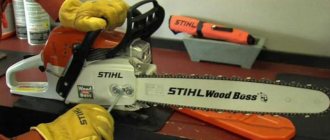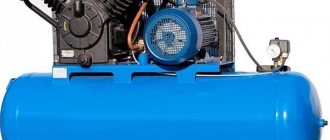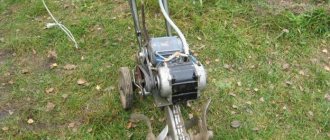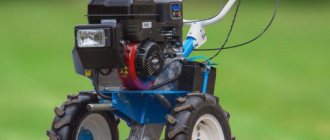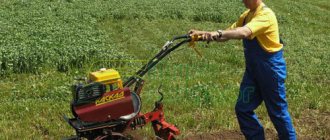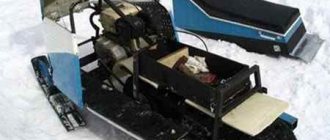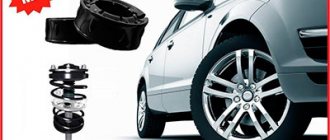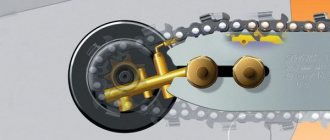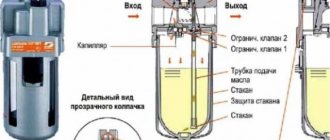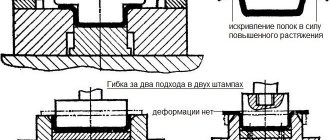With the arrival of spring, difficult times begin for every farmer in caring for his plot, vegetable garden and orchard. This is exhausting digging, weeding, removing any garbage, and mowing the grass. Until recently, everyone managed without the help of technology, but today you can take care of your health and use such universal and practical equipment as the Cascade walk-behind tractor.
In our country, farmers value the Cascade walk-behind tractor precisely for its practicality, versatility and ease of use. However, such equipment requires careful handling and careful maintenance. If any breakdown suddenly occurs, you must, if not repair your unit, then at least identify the cause of the malfunction.
If not, there could be many reasons for this. The breakdown may be related to the engine, carburetor, or clogged spark plugs. We will try to understand this issue, after which you can find out the cause of the breakdown yourself and fix it.
Remember that timely repairs will allow your walk-behind tractor or cultivator to last much longer. Due to lack of time or desire to fix something, in the end the unit simply fails completely. Our recommendations will help you solve the problem when the equipment cannot start.
Carburetor malfunction
As soon as you begin to notice any changes in the operation of the Cascade walk-behind tractor, first of all you need to check the carburetor. It has combustion plugs, and if they are completely dry, then fuel simply does not reach the carburetor itself. There may be a blockage somewhere - in the filter or in the nozzle.
After you remove the carburetor, you must completely remove gasoline from it. Blowing is carried out through the fuel fitting, and the unit itself must be in the same position as inside the walk-behind tractor.
To correct fuel obstruction, the float tongue inside the fuel chamber must be adjusted. The last step is to purge the nozzle. First you need to wash all the parts in gasoline, but under no circumstances wipe them. The moisture should drain on its own. After this, the carburetor is assembled.
Carburetor adjustment is carried out as follows. First, warm up the engine and set the idle speed to its lowest setting. You need to screw in the screw to adjust the gas. After this, you need to add gas and move the control lever. By adjusting by tightening the gas screw, you will achieve normal performance readings of the walk-behind tractor.
Advantages and disadvantages
Judging by operating experience, any Cascade walk-behind tractor is not inferior to leading foreign models. Their reliability fully meets consumer expectations. Despite the low price, this equipment is quite functional and delivers high performance. Thanks to the variety of versions, choosing the most suitable device is not much of a problem. Users can successfully solve various tasks:
- prepare holes;
- to plant plants;
- move heavy loads;
- dig up root crops;
- plow the ground.
The engine power is virtually the same as that of mini-tractors. The frame is reliably protected from corrosion processes with special paint. The engines are carefully selected so that you can work for a long time without worry. This walk-behind tractor (regardless of the series) has no particular disadvantages. Most often, difficulties are associated with untimely or incorrect lubrication.
It must be said that some users also encounter objective problems. Difficulties with the operation of drives and “conflicts” between belts are quite common. The problem is often solved by removing one of the belts, but this invariably results in a loss of performance. Sometimes there are complaints about the weakness of the case material. Therefore, operating a walk-behind tractor on rocky ground is not entirely justified.
Since all walk-behind tractors are relatively large, you will have to immediately think about how to store them. Transportation by personal vehicle (unless it is a cargo Gazelle or something similar) is impossible. Usually you have to order special transportation to a dacha or a country house, since you cannot drive a walk-behind tractor under your own power. However, this problem is common to all walk-behind tractors. If accessories are installed, the carburetor will have to be carefully adjusted.
Engine malfunction
If the Cascade walk-behind tractor does not start at all, then the cause of the breakdown may lie in the engine itself. If too much fuel comes in, the spark plug becomes wet. To eliminate the breakdown, it is necessary to disassemble and dry the cylinder. First you need to turn off the fuel supply. After drying, you need to unscrew the spark plug and use the manual starter to turn on the engine. If after these actions nothing changes, then you need to seek help from professionals.
Another reason why not may be insufficient supply of gasoline to the carburetor, as we discussed just above.
If your walk-behind tractor has an electric starter, then in this case it may not start due to a simple battery discharge. If the malfunction is related to the starter itself, in this case you cannot do without the help of specialists.
Construction of Cascade walk-behind tractors
The Cascade walk-behind tractor is a power plant with a single-cylinder 4-stroke engine installed. All Cascade devices are equipped with DM or Lifan engines. All control levers are located on the steering rod. The transmission is located under the engine. Also connected to the engine are: gearbox, transmission, differential, PTO and clutch.
In the standard version, the Cascade walk-behind tractor drives using pneumatic tires measuring 4x11.
Carburetor
This part is responsible for preparing and supplying the fuel mixture.
If the carburetor mixes in the wrong proportion, this can be seen immediately.
Most often, to restore its proper operation, it is enough to simply adjust the supply of fuel and air to the carburetor. This is done in the following sequence:
- Fully unscrew the adjusting screws that control the maximum and minimum throttle. Afterwards, the bolts should be returned back one and a half turns;
- Let the engine idle for about 10 minutes;
- Place the lever that controls engine speed in the lowest position. In this case, the engine must not stop working;
- Set the throttle valve to the lowest idle speed. The operation of the motor should be clear, without foreign sounds;
- Then use the fuel screws to adjust the gasoline supply (when you tighten the screw, the gasoline supply increases, and when you unscrew it, it decreases).
90 percent of all malfunctions in the carburetor of the Cascade walk-behind tractor are solved by tuning it. If the problem persists, try disassembling and cleaning the carburetor. This is done to remove the resulting carbon deposits and slag.
Setting up the carburetor of the Cascade walk-behind tractor:
The carburetor should be washed with a soft cloth soaked in gasoline. After removing all debris, the carburetor must be thoroughly dried. This is best done using an air compressor; if you don’t have one at hand, then wipe it thoroughly with a dry cloth and let it dry. Then reassemble.
If during disassembly you notice that some part of the carburetor has broken off, then it is not permissible to continue working with such a part! It needs to be replaced with a new one.
Reducer and gearbox
Below are the main problems that arise when operating the Cascade walk-behind tractor from the gearbox side, and ways to solve them:
Oil leaking
This phenomenon may indicate:
- simple overflow of oil in the transmission,
- significant wear or incorrect installation of seals on bearings,
- wear of the pads, the cap not being tightened completely, or foreign particles getting into the air valve.
Inspect each part above to find the cause and then fix the problem.
Difficulty shifting gears
There are several reasons here, let's look at each of them:
- Worn parts in the gearbox. The ends on gears are most often worn. Therefore, the transmission cannot be fixed and constantly breaks down, and its shifting is not controlled. You should disassemble the entire gearbox and inspect the gears; if they are worn, try to grind them as much as possible. If this cannot be done, then replace it.
- The shaft splines are worn or misaligned. To adjust them correctly, they must be equipped with additional locking rings. If they are worn out, then there is only one way out - to change them.
- The clutch is not adjusted correctly. As a result, the gear shift lever is not locked in its final position. This may be a consequence of improper handling of the Cascade walk-behind tractor, when the lever is released before it is properly locked. In this case, you should adjust the clutch and shift gears correctly in the future.
The gearbox is considered a complex unit in which several parts operate simultaneously. You should start repairing the gearbox of a Cascade walk-behind tractor only if you are confident in your abilities. If this is not the case, then you should contact a specialist.
Clutch
The transmission is a part of the Cascade walk-behind tractor, which is designed to transmit rotation from the engine to the shaft, and from it to the attachments.
The transmission of the Cascade walk-behind tractor consists of a clutch, gearbox, differential and final drive.
The most common problem is clutch adjustment.
If the Cascade walk-behind tractor “drives” during operation (the lever is fully pressed, but the machine is trying to move forward), then the adjusting screw should be tightened a little.
If the clutch slips (in other words, when the clutch is fully released, the device does not move, or produces a low number of revolutions), then it must be loosened.
After final adjustment, the clutch screw should be securely fixed so that during operation it is in one position and does not move.
If this does not help, then the problem may be in the flywheel. This is a device that transmits torque from the starter to the crankshaft.
Assembling and installing the flywheel clutch:
The most common wear is observed on the flywheel teeth. This is exactly the part that engages with the shaft and transmits rotation. And their teeth periodically break off.
Therefore, instead of replacing the entire flywheel, you can simply repair it by replacing the crown. This work should only be carried out in workshops.
Belts
Cascade walk-behind tractors operate using a belt drive. They are pulled onto special pulleys. And it is necessary to constantly adjust their tension; if they are loose, then rotation from the engine will occur, but it will not reach the attachment.
On the other hand, if the tension is high, then when receiving a large load it will simply break.
The belt can also wear out and at this time, even with normal tension, break.
Chains
If you do not want to constantly monitor the tension of the belts on the Cascade walk-behind tractor, then they can be replaced with chains. This is a more practical option that guarantees constant reliable operation without failures. The only exception is those moments when the chain is too weak and falls off.
In this case, it is necessary to additionally replace the tension rollers with sprockets of the appropriate size.
A clear advantage is that chains can withstand much greater pressure than belts. Cascade walk-behind tractors are professional, and their weight is 160 kg, and an even greater load is provided by attachments. Chains break much less often, so the choice in their direction is obvious.
Ignition
The ignition is the part that powers the motor of the Cascade walk-behind tractor. At the end of the work, the engine is also turned off by the ignition.
As standard, Cascade walk-behind tractors are equipped with a manual starter. And the engine starts by hand using a cable. This is difficult to do and the starter often does not start the first time. This is especially pronounced in winter, when the air temperature is low and the engine parts are cooled.
Therefore, a manual starter is often replaced with an electric one. To operate such a device, it is necessary to additionally equip the Cascade walk-behind tractor with a battery. The electric starter is powered by it.
Adjusting the engine ignition of walk-behind tractors in the following video:
It is important to monitor the condition of the spark plugs and the gap between them. They give a spark and burn the fuel mixture. In normal condition, they should be firmly fixed in the grooves and have a fixed gap of 0.6-0.7 mm.
The power caps must sit firmly on the spark plugs. There should be no soot or slag on them, as this interferes with the production of a spark and its supply. If the carbon deposits are not removed, the spark plug must be replaced with a new one.
Diesel or gasoline engines
A motor cultivator is a universal equipment for working on a personal plot. It helps to cultivate the soil between the beds, between the trees. With its help you can easily get rid of weeds. The walk-behind tractor is much more functional equipment due to the fact that any attachments can be attached to it. This is essentially a mini-tractor, potato digger, plow, and cultivator at the same time.
The walk-behind tractor can have a diesel or gasoline engine. The startup in this case will be different, therefore, the cause of the breakdown may be different. Most often, the unit does not start after winter. Staying in a cold and damp room for a long time leads to such unpleasant moments as:
- clogged jets in the carburetor;
- damage to the insulation in the wires;
- oxidation of contacts;
- oil watering.
Before starting the walk-behind tractor for the first time, you must carefully check all the parts. Thus, there should be no clamping of the harness threads, and the lack of oil in the crankcase will lead to damage to the piston system.
The engine may not start due to old oil. This produces white exhaust smoke. In this case, a complete oil change is necessary.
There are units on sale that have protection against insufficient oil level, when it immediately begins to stall. Monitor the oil level carefully.
Also, the service life of a walk-behind tractor depends on the quality of gasoline. You should not refuel your unit with cheap gasoline, which can cause serious damage.
A diesel walk-behind tractor can also present unpleasant surprises immediately after purchase. It may not start due to air that has entered the fuel supply system. To fix it, you need a diesel supply valve, unscrew all connections along the fuel channels. The last step is to purge the nozzle.
The Cascade walk-behind tractor does not start - reasons and do-it-yourself repairs
Gardening equipment today is in great demand precisely because of its versatility.
Today, you no longer have to manually plow huge fields or even small vegetable gardens; you no longer need to dig up and manually collect potatoes, or remove snow from your garden plot in winter. All this will be done for you by special equipment. Cascade walk-behind tractors are manufactured in Russia and are one of the most popular gardening equipment in the country. This is not surprising, because they have excellent technical characteristics and will last for many years.
However, it happens that the device fails. When the Cascade walk-behind tractor starts up and stalls, you need to immediately look for the cause of the breakdown. Otherwise, you may make the problem even worse.
Malfunction in the ignition system
First you need to inspect all the parts of the ignition system, and if there is no visible damage or contamination, you need to check each component in more detail.
If there is no spark, then the cause is the spark plug. It is necessary to check the gap and condition of the electrodes. If necessary, the fumes are removed, but experts recommend completely replacing the spark plug.
You also need to carefully examine the intake and exhaust valves. They must fit securely to the saddles. Combustion products gradually accumulate in the muffler, which leads to the engine stalling. It needs to be cleaned periodically.
Motor malfunctions
Motor problems can be indicated by spontaneous stopping, lack of power levels and interruptions:
- If the unit is equipped with a gasoline engine, then in the process of searching for problems you need to check whether there is fuel in the tank, what is the condition of the special damper of the device, how the ignition is started, whether fuel flows into the carburetor.
- To check the final condition, you need to fill a special chamber using one button. In this case, fuel should pour out of the hole in the lid of this chamber. If gasoline flows in a small stream or is not visible at all, this may be a problem with a dirty fuel filter or a clogged valve in the device. The recommendation for repairing this walk-behind tractor in this case advises cleaning the valve or filter.
Oil in a walk-behind tractor engine: what kind to pour, how to check the level or replace it
If you purchased a walk-behind tractor to work on the site, you will have to constantly check the technical condition of the equipment. Thus, you can extend the life of your iron assistant. The question immediately arises of what kind of oil to use in the walk-behind tractor engine: what kind to pour, how to check the level or replace it.
Walk-behind tractor
First, you need to read the instructions, which will tell you everything. Manufacturers of walk-behind tractors recommend those oils that can minimize the occurrence of malfunctions during operation of the unit. It is necessary to remember that engine oil performs four functions at once during operation of the machine:
- lubricant;
- compaction;
- cooling;
- cleaning
With constant operation of air-cooled engines, oxidation and burning of the lubricant occurs, which remains on the hot cylinder. As a result, there is a lot of smoke in the exhaust.
Change of oil
In addition, the deposition of resinous substances begins in the engine, which become the main cause of contamination of some parts. At the same time, sludge appears, which makes lubrication of the unit more difficult, as shown in the photo.
In this case, it is recommended to use antioxidant agents together with the oil. They are able to clean the engine of contaminants and remove harmful deposits. You can use high quality petroleum products from some foreign manufacturers. Such products are already produced with the necessary additives, as shown in the photo.
It is necessary to choose the correct type of oil according to the SAE classification. If you have a walk-behind tractor like Neva, Cascade, Ugra, Subaru, Lifna, it is better to use lubricant, taking into account the temperature conditions of your area. When using a petroleum product like 10W30 at a temperature of 5 degrees or higher, its consumption will be much greater, and this can also lead to engine damage.
Choice
It is necessary to fill in the lubricant that is recommended in the instructions supplied with the equipment by the manufacturer. If you purchased a diesel unit, then the lubricant should be diesel. In addition, depending on the season, it can be summer or winter; If your iron assistant is fueled with gasoline, oils of different viscosities according to SAE and API classes are used. In warm weather, you can use semi-synthetic lubricant SAE 30 5w30. It is better to fill a walk-behind tractor that will operate in winter with 0w40 synthetic oil. The cost of this product is high. However, reading the reviews, you come to the conclusion that it is better to pay more for lubricant than to then change the engine;
Therefore, know that saving in this case leads to disastrous results. It is known that the better quality lubricant you pour into your car, the better the engine will work. Low quality products will definitely lead to malfunction of the entire unit;
So what kind of oil is best to fill in a walk-behind tractor engine? Information about the brand of lubricant for such units as Neva, Cascade, Ugra, Subaru, Lifna can be found in the attached instructions. Car owners, according to their experience, note in their reviews that lubricant is poured into the walk-behind tractor depending on the time of year. So, in the summer it is better to use a semi-synthetic agent -10W-40, and in cold weather - a synthetic 5W-40;
To pour lubricant into the engine, you need to open the hole cover. The old grease must be drained. Liquid (about 600 g) is poured into the engine using special devices to the required level - the last turn in the neck. Usually, the filler housing is slightly inclined, which makes it possible not to overfill the lubricant. At the end, screw the lid on tightly, as shown in the photo.
When to change
Now that you have decided which lubricant is suitable for your equipment, you need to worry about a clear sequence for replacing it. A new, just purchased walk-behind tractor needs to be run in for the first 5 hours. After this, be sure to make the first lubricant change in the engine. If this is not done, all the production debris deposited in the engine during assembly will mix with the oil and the machine will stop working immediately. To completely remove debris, it is better to repeat replacing the oil product after another 5 - 7 hours. The next fluid change should be made after 30-55 hours of operation.
If you use the unit every day full time, then the fluid must be changed every 25 hours. If you do not use your iron horse often, the lubricant in the unit can be replaced after 50 hours of operation. However, before starting spring work on the site, in any case it is necessary to change the oil.
Let's sum it up
Experts advise using oil according to the operating instructions for the walk-behind tractor. However, a lot depends on the conditions in which the walk-behind tractor operates.
And when to change the lubricant in the engine, you can determine by the color: if it turns black, change it immediately so as not to “screw up” the car.
fermerteh.ru
Why the walk-behind tractor does not start - we understand the reasons
Before the start of the season, it is necessary to prepare both gasoline and diesel walk-behind tractors. To do this, the owner of the device must make sure that the design of the device has all the necessary parts for operation, and each of them “sits” tightly in its usual place.
Often, many walk-behind tractors equipped with a Subaru engine or engines of other well-known brands refuse to work after a long winter period of inactivity. At the same time, improper storage conditions for an agricultural machine also affect it - if it was parked in a cold, damp room, it is likely that it will not start before spring work begins. This is due to a number of problems:
- Oxidation of contacts in electrical wiring;
- Violation of the integrity of the wiring insulation;
- Watering oil and fuel;
- Debris accumulation in carburetor injectors.
Before starting the walk-behind tractor, its owner must carefully check all the connections that are provided in the design of the device. It is necessary to check the movement of the gas cables, reverse gear and traction - it should be soft. If during inspection you find clamps or twisted cables, you will not be able to start the walk-behind tractor.
Before starting the walk-behind tractor for the first time, check the oil level inside the crankcase. If there is no oil, it will seriously damage the piston group. Judge for yourself: at a crankshaft speed of 1400 rpm, a second is enough to form several burrs on the surface of the cylinder.
Oil left over for the winter is one of the main reasons for unstable engine operation. To verify that an off-road tractor is bad for this reason, it is quite simple - after starting, white smoke will come out of the vehicle's exhaust pipe for a few seconds, after which the unit will lag. Do not forget that both a diesel engine and a gasoline walk-behind tractor start poorly due to lack of oil. Some unit models are equipped with low level protection; Owners of other cars must independently control the amount of oil inside the tank.
READ Which engine is better for a walk-behind tractor?
Another important factor is the gasoline you use to fuel your walk-behind tractor. If you regularly fill up with the wrong brand of fuel recommended by your vehicle's manufacturer, this may also prevent your vehicle from starting.

